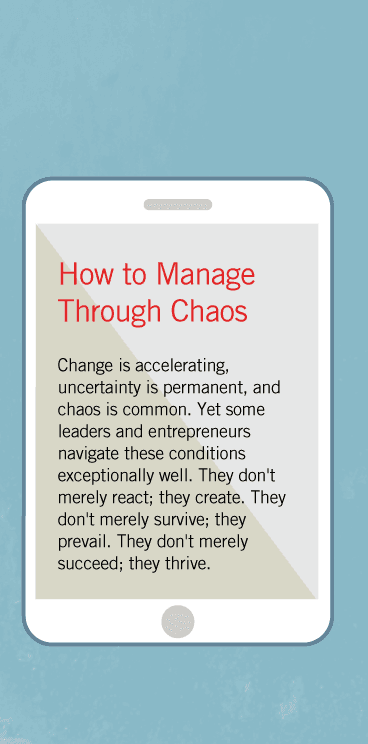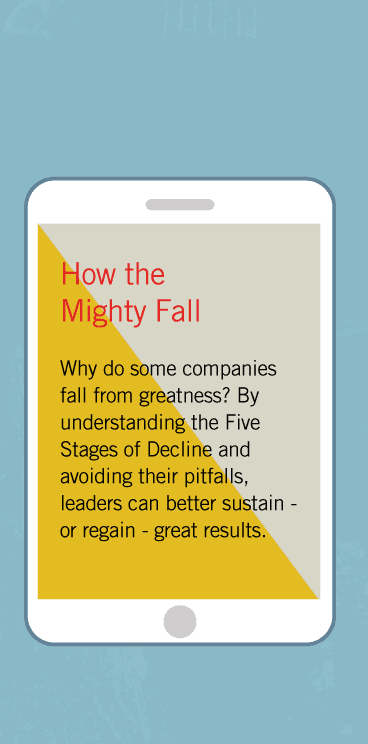Building Companies to Last
In a world of constant change, the fundamentals are more important than ever
In this era of dramatic change, we’re hit from all sides with lopsided perspectives that urge us to hold nothing sacred, to “re-engineer” and dynamite everything, to fight chaos with chaos, to battle a crazy world with total, unfettered craziness. Everybody knows that the transformations facing us—social, political, technological, economic—render obsolete the lessons of the past.
Well, I submit that “everybody” is wrong. The real question is, what is the proper response to change? We certainly need new and improved business practices and organizational forms, but in a turbulent era like ours, attention to timeless fundamentals is even more important than it is in stable times.
To identify those timeless fundamentals, Jerry Porras and I embarked upon the intensive six-year research project that led to our book Built to Last. We studied the founding, growth, and development of exceptional companies that have stood the test of time, companies like Hewlett-Packard, 3M, Motorola, Procter & Gamble, Merck, Nordstrom, Sony, Disney, Marriott, and Wal-Mart. Those “visionary companies” had both endurance, with an average age of nearly 100 years, and sustained performance. For example, their stock has performed 15 times better than the overall stock market has since 1926. We also studied each visionary company in contrast to a “comparison company” that had roughly the same shot in life but didn't turn out as well—3M with Norton, P&G with Colgate-Palmolive, Motorola with Zenith, and so on.
By studying companies that have prospered over the long term, we were able to uncover timeless fundamentals that enable organizations to endure and thrive. We studied those visionary companies not only as big business but also as start-ups and growth companies. And they succeeded from their earliest days by adhering to the same fundamentals that can help today’s growth companies emerge from the turbulence of the 1990s to become the HPs, 3Ms, and P&Gs of the 21st century. By paying attention to the six timeless fundamentals that follow, you can learn from what those organizations did right and build your own visionary company.
Make the company itself the ultimate product—be a clock builder, not a time teller
Imagine that you met a remarkable person who could look at the sun or the stars and, amazingly, state the exact time and date. Wouldn’t it be even more amazing still if, instead of telling the time, that person built a clock that could tell the time forever, even after he or she were dead and gone?
Having a great idea or being a charismatic visionary leader is “time telling;” building a company that can prosper far beyond the tenure of any single leader and through multiple product life cycles is “clock building.” Those who build visionary companies tend to be clock builders. Their primary accomplishment is not the implementation of a great idea, the expression of a charismatic personality, or the accumulation of wealth. It is the company itself and what it stands for.
Take for example, T.J. Rodgers, founder and CEO of Cypress Semiconductor. Brilliant, self-assured, technically sophisticated, and guided by a fierce “take no prisoners” drive to win. Rodgers came to Jerry and me several years ago. “I want to go beyond the fast-growing entrepreneurial success,” Rogers told us. "I want to build Cypress into a monument company.”
“Tell me, T.J.," I responded, "what is the most important product you are working on right now?” He threw out a highly technical name. I disagreed with him.
“How can you?” he asked. “You don’t know the technology. You don’t know my business the way I do. You don’t know the market."
I then told him how David Packard, when asked to name the most important product decisions contributing to Hewlett-Packard's remarkable growth rate, answered entirely in terms of the attributes of the Hewlett-Packard organization—the importance of granting immense operating freedom within well-defined objectives, the pay-as-you-go policy that enforces entrepreneurial discipline, the critical decision to enable all employees to share in the company's financial success. David Packard was clearly a clock-building leader.
Now, whenever T.J. Rodgers is asked about the most important product he is working on, he answers firmly, "Cypress Semiconductor Corporation." By making the shift from time telling (being a great product visionary) to clock building (creating a great organization), he has taken perhaps the single most important step in transforming his hot-growth company into a visionary company that's built to last.
Achieving that transformation requires turning the world upside down and inside out, seeing products and market opportunities as vehicles for building a great company, not the other way around. In fact, only 3 of our 18 visionary companies began life with a "great idea." As we move into the 21st century and products, technologies, and markets blast through their life cycles, clock-building styles of leadership will become even more important.
Build your company around a core ideology
In 17 of the 18 pairs of companies in our research, we found the visionary company was guided more by a core ideology—core values and a sense of purpose beyond just making money—than the comparison company was. A deeply held core ideology gives a company both a strong sense of identity and a thread of continuity that holds the organization together in the face of change.
We chose the word ideology because we found an almost religious fervor in the visionary companies as they grew up that we did not see to the same degree in the comparison companies. 3M's dedication to innovation, P&G's commitment to product excellence, Nordstrom’s ideal of heroic customer service, HP’s belief in respect for the individual—those were sacred tenets, to be pursued zealously and preserved as a guiding force for generations.
Build a cult-like culture
Architects of visionary companies don’t just trust in good intentions or “values statements;” they build cult-like cultures around their core ideologies. Walt Disney created an entire language to reinforce his company's ideology. Disneyland employees are “cast members.” Customers are “guests.” Jobs are “parts” in a “performance.” Disney required—as the company does to this day—that all new employees go through a “Disney Traditions” orientation course, in which they learn the company's business is “to make people happy.”
The same spirit holds at smaller visionary companies, like Granite Rock, a rock-and-asphalt business in Watsonville, CA., and recipient of the 1992 Malcolm Baldrige National Quality Award (See "The Change Masters," Inc., March 1992.) Co-CEO Bruce W. Woolpert hates the word “employees;” they are “Granite Rock People.” And not just anyone can be a Granite Rock Person. Bruce and Steve Woolpert have a deeply rooted ideology of quality, service, and fairness that harks back to the early days of this century, and if you don't accept that ideology, you simply don’t belong at Granite Rock. Period. No matter how much business you might bring in.
Homegrow your management
In more than 1,700 years of combined history, we found only four cases in our visionary companies in which an outsider was hired as chief executive—and that in only 2 of the 18 companies! In contrast, our less successful comparison companies were six times more likely to go outside for a CEO. Our findings simply do not support the widely held belief that companies should hire outsiders to stimulate change and progress.
Indeed, as great companies grow up, we see continuity and order in management tenure and succession. Insiders preserve the core values, understanding them on a gut level in a way that outsiders usually cannot. Yet insiders can also be change agents, building on the core values while moving the company in exciting new directions.
Bob Galvin spent years learning from his father, Paul Galvin, founder of Motorola, before becoming CEO. Bob Galvin then kept Motorola’s core ideology intact and simultaneously revolutionized the company. At the very moment he began that revolution, by moving the company out of television sets and into solid-state electronics, integrated circuits, and cellular communications, Bob Galvin also began succession planning for the next generation of leadership—a full quarter of a century before he would pass the reins—to maintain a lineage of homegrown leaders to preserve Motorola's core values.
At our comparison companies we frequently saw management gaps—often due to egocentric leaders who simply could not conceive of the organization without themselves at the helm. “Commander” Eugene F. MacDonald Jr., the brilliant founder of Zenith, never planned for his succession. Since his death in the late 1950s, Zenith has been plagued by spotty leadership—at times from the outside—that allowed the company to drift from its founding values. Motorola, however, has sailed on into exciting new arenas for the past 30 years, guided by an unbroken string of capable, long-tenured, homegrown leaders. What has Zenith done?
The notion that “founder-entrepreneur types” are constitutionally incapable of building and managing companies is bunk. Consider that the founders of Ford, Hewlett-Packard, Johnson & Johnson, Marriott, Merck, Motorola, Nordstrom, Philip Morris, Procter & Gamble, Sony, Wal-Mart, and Disney remained in the role of chief executive for an average of 37 years each. They were founder-entrepreneur types and manager-builder types. Not only that, their immediate successors—all homegrown insiders—remained in office for 24 years on average. Stability indeed.
Stimulate progress through BHAGs, experimentation, and continuous improvement
To build a visionary company, you need to counterbalance its fixed core ideology with a relentless drive for progress. While core ideology provides continuity, stability, and cohesion, the drive for progress promotes change, improvement, innovation, and renewal.
One way to bring that drive for progress to life is through BHAGs (short for Big Hairy Audacious Goals). With his very first dime store in 1945, Sam Walton set the BHAG to “make my little Newport store the best, most profitable in Arkansas within five years.” As the company grew, Walton set BHAG after BHAG, including the still-in-place goal to become a $125-billion company by the year 2000. The point is not to find the “right” BHAGs but to create BHAGs so clear, compelling, and imaginative that they fuel progress.
A second way to simulate the drive for progress is to create an environment that encourages people to experiment and learn—to try a lot of stuff and keep what works. 3M began life as a failed mine and could not pay its first president a salary for 11 years. Yet it grew into one of the most innovative companies in history, eventually branching into more than 60,000 new products. In contrast, Norton (3M’s comparison in our study) began life with a revolutionary new grinding wheel that propelled the company to spectacular early growth. Yet Norton became a stodgy old-line company, with no reputation for sustained innovation. 3M’s clock builders created an environment where people were encouraged to try just about anything, and were given 15% of their time to do so. “Our company has, indeed, stumbled onto some of its new products," an early CEO once noted. "But never forget that you can stumble only if you're moving." Norton, on the other hand, stifled experimentation and discouraged people from working on anything but grinding wheels. "You could work on anything you wanted as long as it was round and had a hole in it," recalled one Norton research scientist.
In a visionary company, continuous improvement is a way of life, not a management fad. The critical question is not “How can we do well?” or “How can we meet the competition?” but “How can we do better tomorrow than we did today?” The challenge is to build for the long term while doing well today.
Embrace “the genius of the and”
If there's one lesson from our finding to keep in mind above all others, it is this: Clock build your company so that it preserves a passionately held core ideology and simultaneously stimulates progress in everything but that ideology. Preserve the core and stimulate progress. A truly visionary company embraces both ends of a continuum: continuity and change, conservatism and progressiveness, stability and revolution, predictability and chaos, heritage and renewal, fundamentals and craziness. And, and, and.
Take Sam Walton, who thrived on frenetic activity and created an organization that encouraged employees to experiment with crazy ideas like hanging stuffed monkeys from a tree as part of a store promotion on romping through the "Wal-Mart cheer" or Walton himself shimmy-shaking down Wall Street in a hula skirt. But you can be crazy at Wal-Mart only if you're first and foremost serving the customer. "If you're not serving the customer or supporting the folks who do," Walton held, "then we don't need you."
The same adherence to a core ideology holds true at Manco, a company in Cleveland. (See "Steal This Strategy," Inc., February 1991.) Manco is raucous and fast moving. People in yellow duck outfits waddle through the halls. (Manco sells duct tape, which sounds like duck, and, well, you get the idea.) To celebrate successes, top salespeople yell the Manco cheer and plunge into an ice-cold pond. Plus, people have wide latitude to make decisions and act fast without waiting for approval from above.
Yet Manco's CEO Jack Kahl has clearly built his company around a few tightly fixed core values—quality, service, respect, and a love of learning. The company is also passionate about getting the nuts and bolts consistently right. Is Manco an irreverent, crazy organization, or is it a religiously disciplined organization? Both! Like Wal-Mart, Manco embraces “The Genius of the And.”
We read much these days about radical new business practices and organizational forms: “virtual” corporations, “empowered” organizations, “neo-biological” organizations, and so on. And that is good. Indeed, the ability to create organizational innovations is more important in building a great company than the ability to create product, technology, and market innovations.
Yet the truly great companies of the 21st century will change within the context of their core ideologies while also adhering to a few timeless fundamentals. In The Idea of Ideas, Bob Galvin, former CEO of Motorola, wrote: "Change unto itself is essential. But, taken alone: it is limited. Yes, renewal is change. It calls for 'do differently.' It is willing to replace and redo. But it also cherishes the proven basics." By being clear about their core vales and guiding purpose—about what should not change—companies can feel liberated to experiment with everything else.






